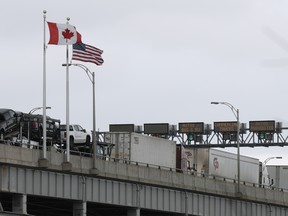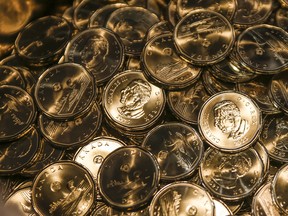The reprieve could provide Canadians with an opportunity to prepare if tariffs come to pass
Article content
Prime Minister Justin Trudeau announced on Monday that U.S. tariffs on Canada would be “paused” for up to 30 days, after agreeing to border security measures in an afternoon call with U.S. President Donald Trump. While the countries have called a fragile truce for the time being, Canada is not out of the woods just yet.
Article content
Article content
If the two sides fail to negotiate a deal before March 1 and the tariff war materializes, economists have warned that consumers on both sides of the border will see drastically higher prices. With that possibility in mind, here’s what Canadians can expect and how they might prepare as the next deadline approaches.
Advertisement 2
Article content
How would the tariffs work?
In the tumultuous period leading up to the announced pause, Trump was threatening to slap a 25 per cent tariff on most Canadian goods and 10 per cent on energy exports.
In retaliation, Canada’s announced it would match Trump’s with 25 per cent tariffs on American imports as well. Canada’s original plan was a two-parter: tariffs on $30 billion in goods imported from the U.S. in the first phase and tariffs on an additional $125 billion of goods three weeks later.
Tariffs are first paid by the importer — which means the 25 per cent tariff imposed on an American good is paid by the company importing the good from the United States into Canada, with the revenue going toward the Canadian government, and vice versa for Canadian goods imported into the U.S.
It’s possible that businesses will choose to absorb some of the costs to avoid losing customers, says Nathan Janzen, assistant chief economist at Royal Bank of Canada (RBC). “That can be particularly true in an economy like Canada’s, where we’ve been underperforming, our demand is weaker already to begin with, and it might be more difficult for businesses to pass on those costs,” Janzen explained.
Article content
Advertisement 3
Article content
This is more common on the importer side, in which the company importing goods from another country pays the tariff without passing on the higher cost. While it’s less typical for the exporting business to eat some of those higher costs in the short-term, it could occur later on, noted Tu Nguyen, economist with assurance, tax and consultancy firm RSM Canada.
“For the exporter, they might not want to lower prices significantly right away, because if the tariff is removed later, it might be harder to increase prices back up again,” Nguyen explained. “It’s a strategy the exporter would (only) do if they feel like, first, they can absorb the (loss), and second, if they feel that the tariff is there to stay, at least for some time.”
Should consumers expect prices to go up 25 per cent, in line with tariffs?
Nguyen says most of the data she’s seen indicates that the bulk of the tariff costs get passed onto the consumer. But a 25 per cent tariff doesn’t necessarily mean a straight 25 per cent price increase for the customer.
The price of a good is dependent on the cost of its components or raw materials, the labour that goes into producing it and the costs of transportation (which could include the costs of gas and the wages of the delivery driver).
Advertisement 4
Article content
Janzen said the big risk of tariffs in North America is that an intermediate product could cross the border repeatedly, which means it gets taxed each time. He pointed to auto parts as an example, which could cross the border up to eight times before final assembly.
“A 25 per cent across-the-board tariff can be the equivalent of a 250 per cent tariff for some products,” he said. “That’s the impact that builds over time.”
Andreas Schotter, a professor of international business at Western University’s Ivey Business School, offered the example of imported American bread, which uses some Canadian raw materials, like yeast.
“If a 25 per cent tariff is imposed on Canadian yeast entering the U.S., this will increase production costs on the material side,” Schotter wrote in an email. “When the finished bread is exported back to Canada, it will face an additional 25 per cent tariff.”
Schotter added that consumers need to account for retail markups as well, which are “typically between 80 per cent and 100 per cent, with baked goods among the highest-markup categories.” He projected that a $3.50 loaf of bread could cost consumers $5 as a result of tariffs on both sides of the border (a 43 per cent price increase).
Advertisement 5
Article content
Nguyen pointed out that the currency exchange can impact prices as well. American shoppers could see higher costs for Canadian goods mitigated by the Canadian dollar depreciating against the greenback. On the other hand, Canadian consumers could feel the pain of higher prices on American goods more keenly.
How can Canadian consumers prepare?
Of course, Canadians can consider other options, like purchasing products imported from other countries or goods that are domestically produced. Multiple provinces were set to pull U.S. liquor from store shelves with the directive to buy Canadian-made booze before tariffs were paused.
“Not everything we consume is imported,” Janzen emphasized, explaining that about 80 per cent of Canada’s total consumer expenditure comes from domestic-produced products. From the remaining 20 percent of foreign imports, about half comes from the United States.
He advised consumers to be price-conscious and check product labels for the country of origin while doing their shopping. “Usually, in the absence of tariffs, higher prices are associated with higher quality, (but) that might not be the case for a while,” he said.
Advertisement 6
Article content
What else should Canadians keep in mind?
Buying non-American alternatives isn’t an easy swap for all goods and services across the board. While the first phase of tariffs on American imports is said to impact goods that could be replaced with domestic items or imports from other countries, such as alcohol and apparel, Nguyen said the second phase is when “the pain would really hit” Canadian consumers.
“The goods that are subject to tariffs in the second wave include auto parts, trucks (and) cars,” she said, noting these goods face tariffs on both sides of the border. “Canadian consumers might have quite a difficult time ahead.”
During Trump’s first administration, when the U.S. imposed a 20-per cent tariff on softwood lumber, and later, a 25-per cent tariff on steel and 10-per cent tax on aluminum products, Canada also responded with retaliatory tariffs. However, tariffs on both sides were lifted just one year later after the countries negotiated a new trade agreement.
Recommended from Editorial
-

EU prepares to hit Big Tech in retaliation for tariffs
-

China targets Nvidia, Google as Trump tariffs bite
“The Trump administration has been known to announce things and then backtrack … these things later,” Nguyen said. “So, we could hope that this is a rather short-lived thing, and the impact is minimized on consumers, but obviously nothing is for certain.”
• Email: slouis@nationalpost.com
Bookmark our website and support our journalism: Don’t miss the business news you need to know — add financialpost.com to your bookmarks and sign up for our newsletters here.
Article content
Why 25% tariffs doesn’t necessarily mean 25% price hikes
2025-02-05 19:42:30







